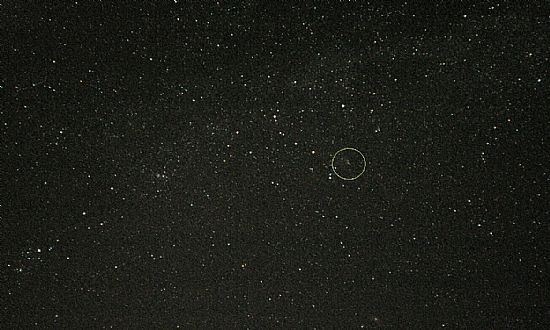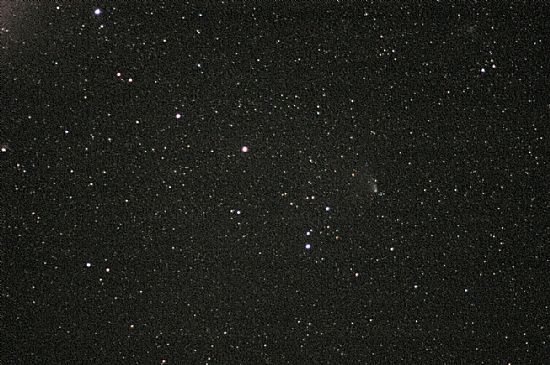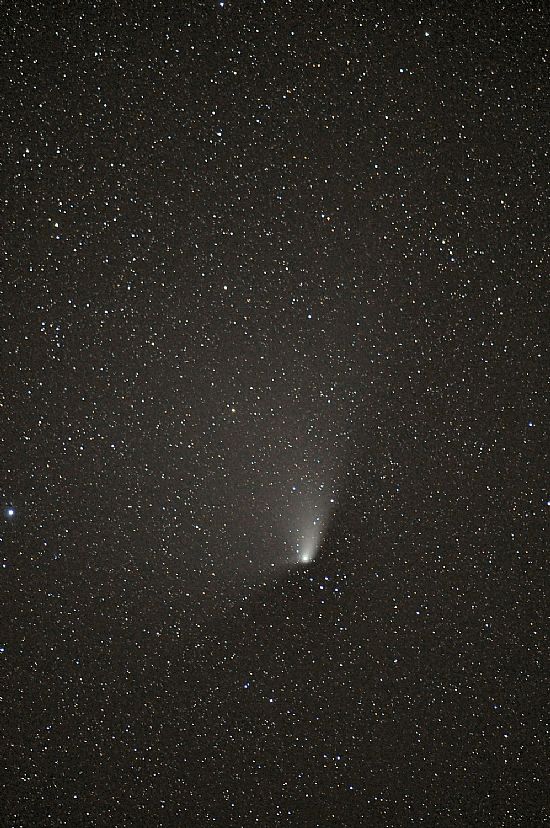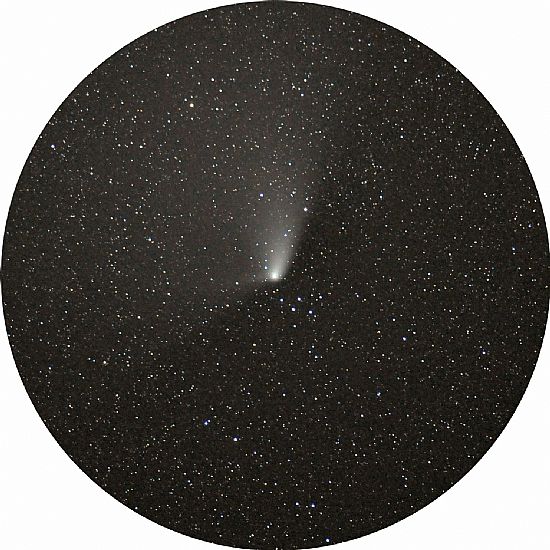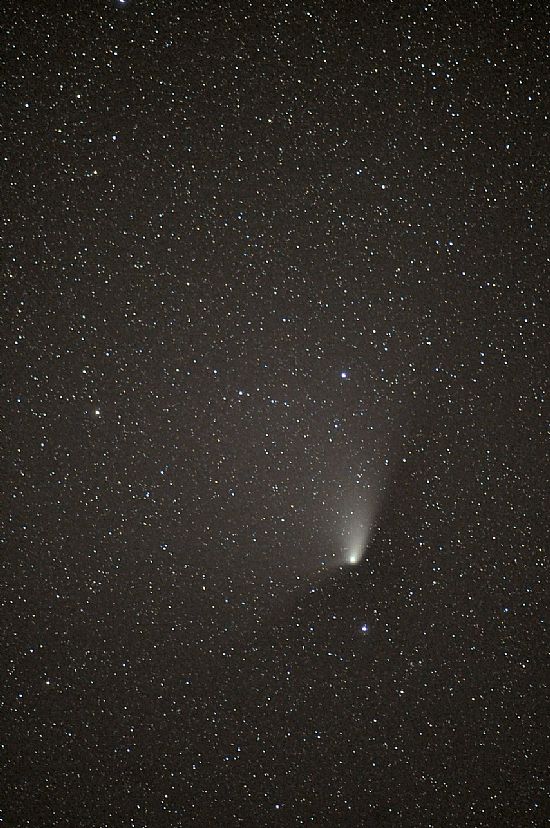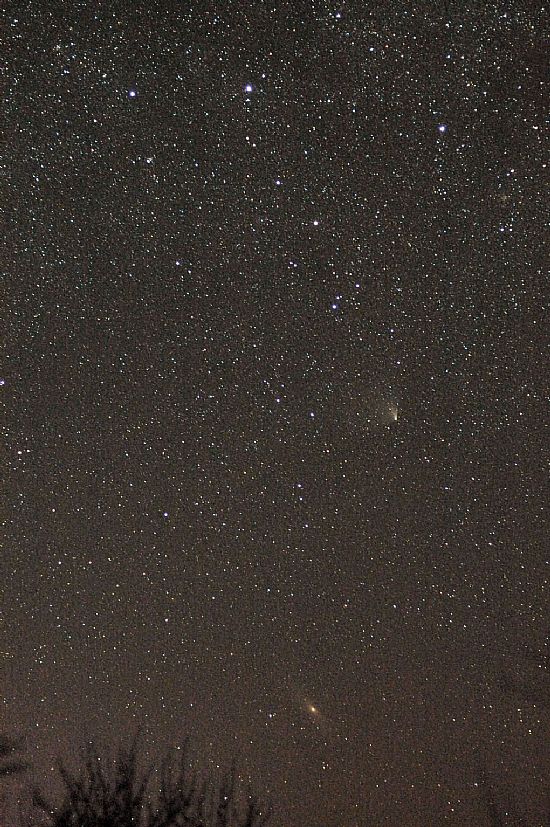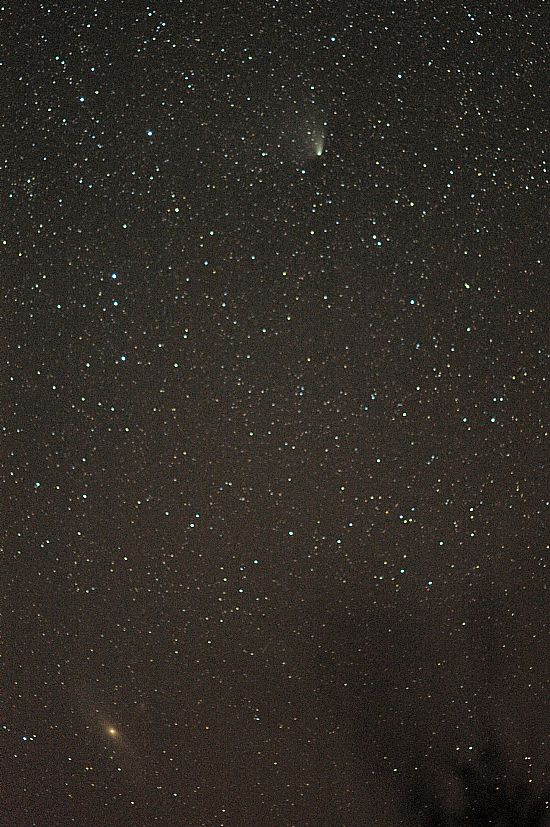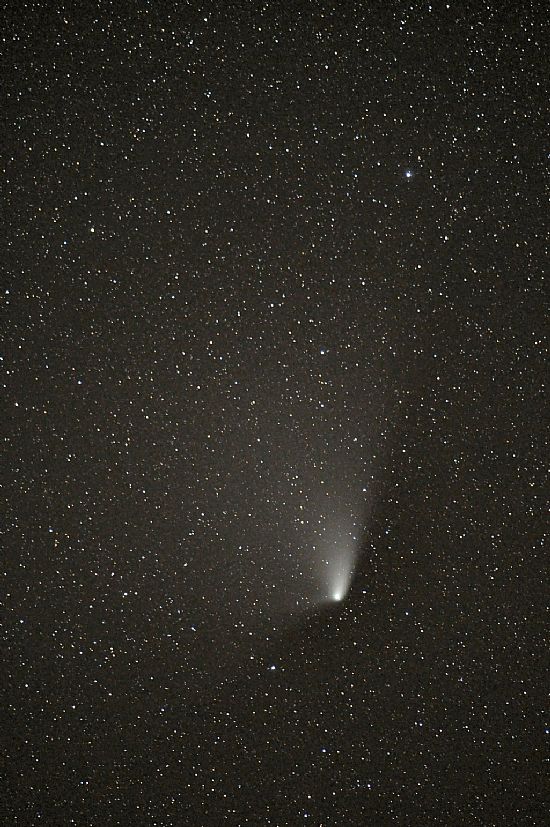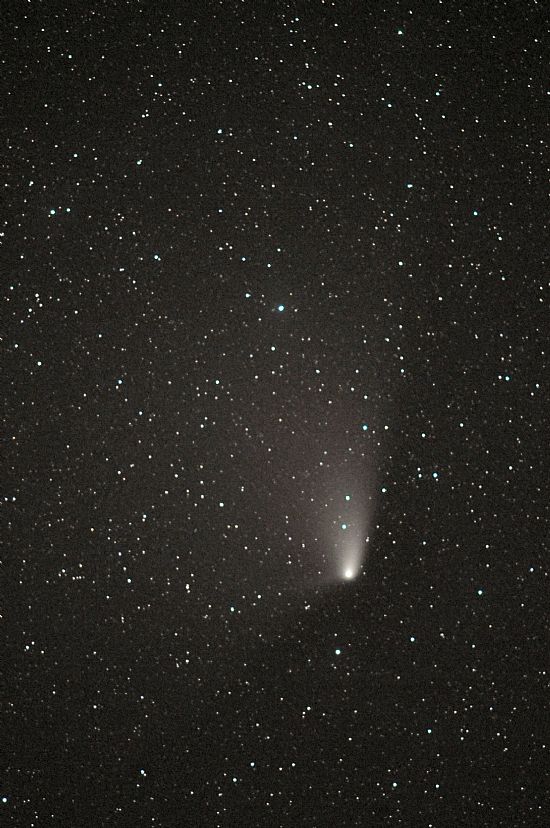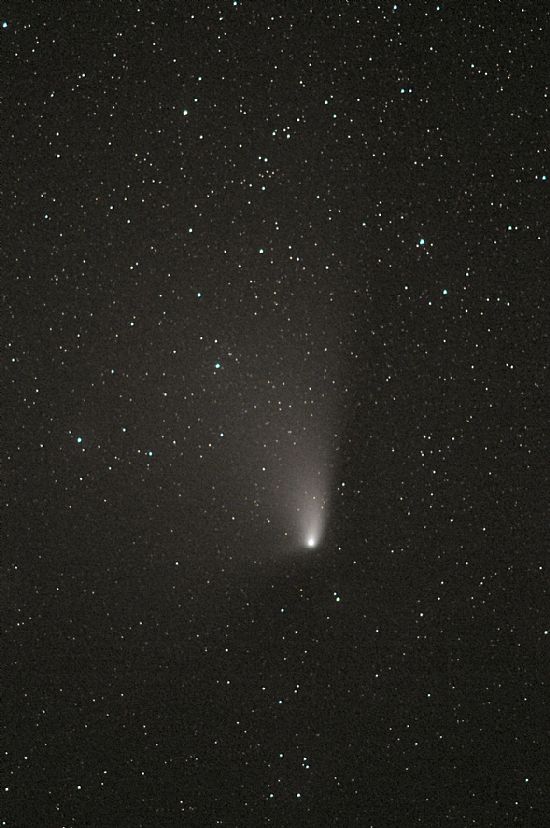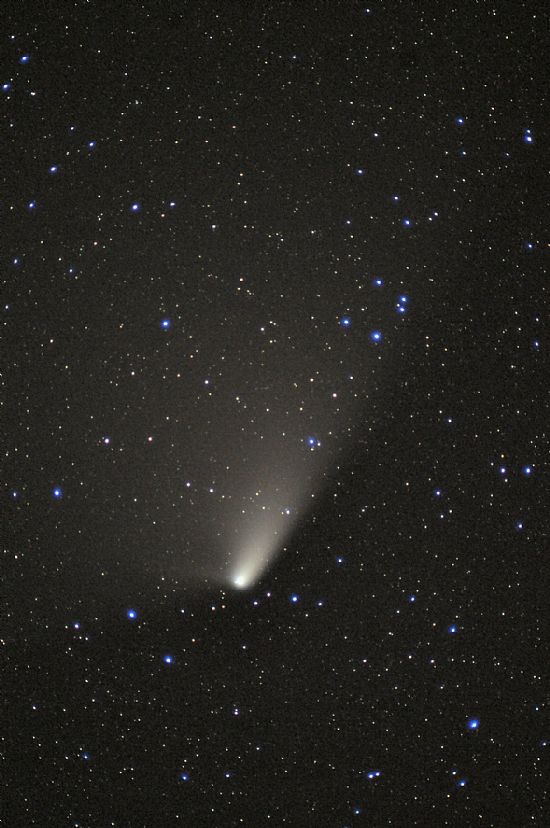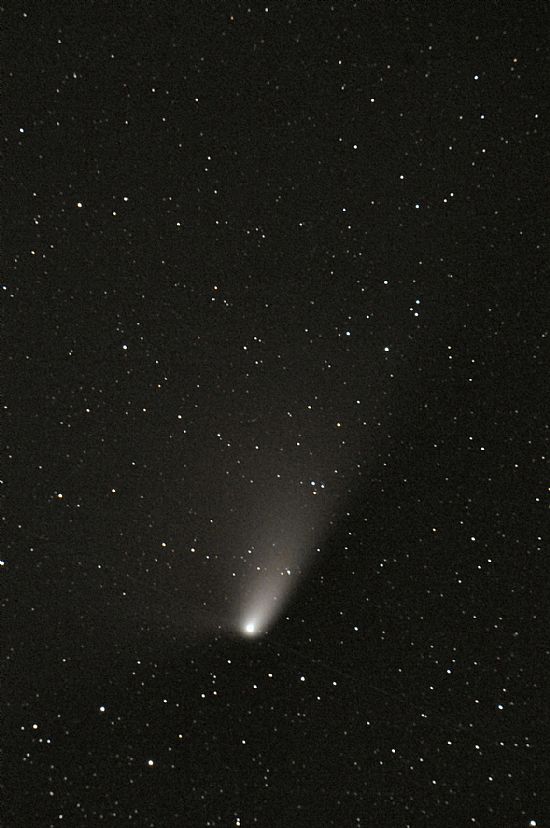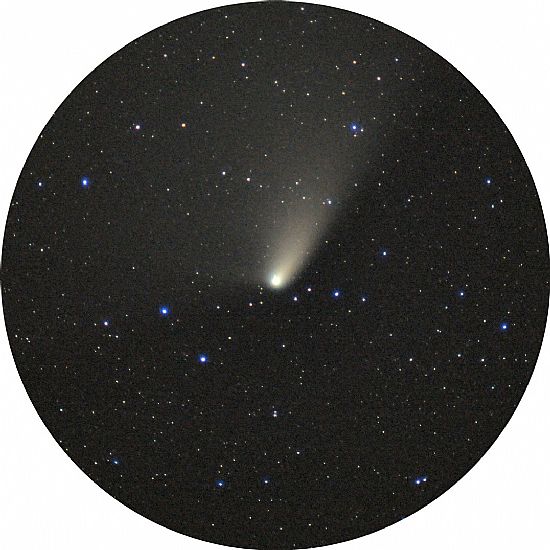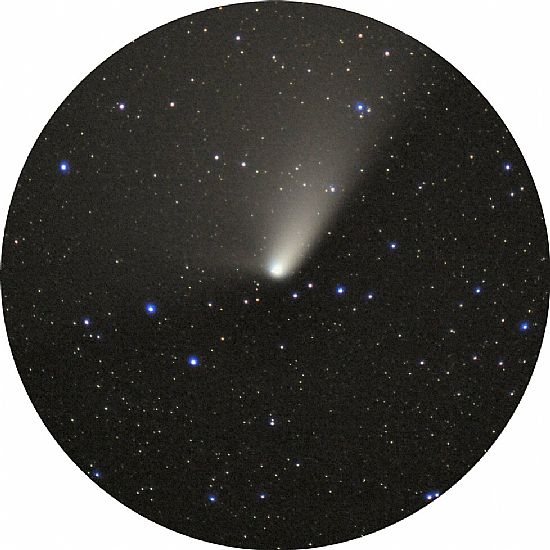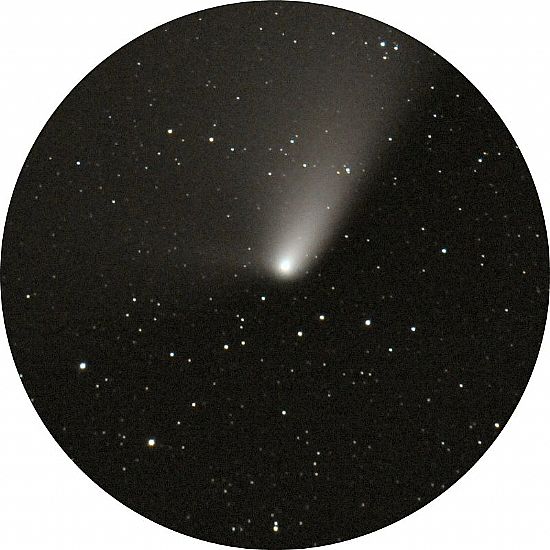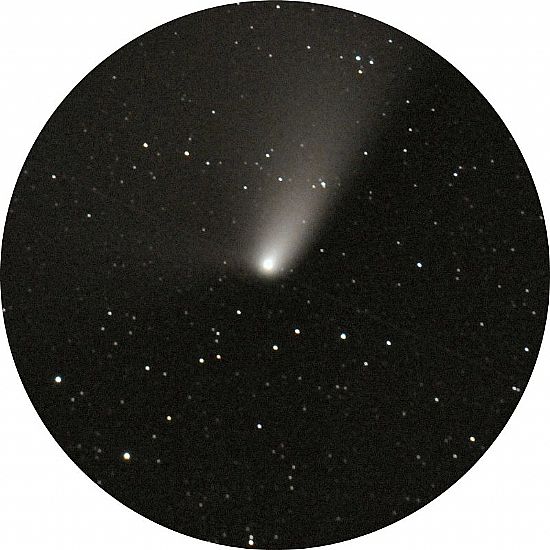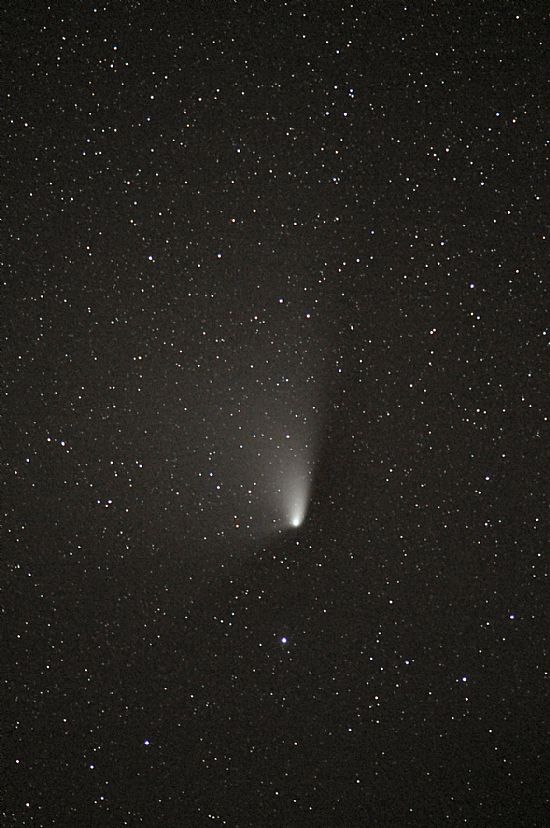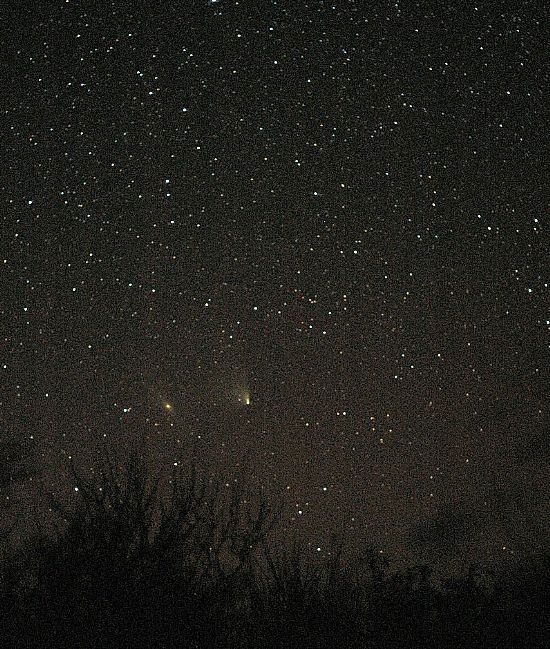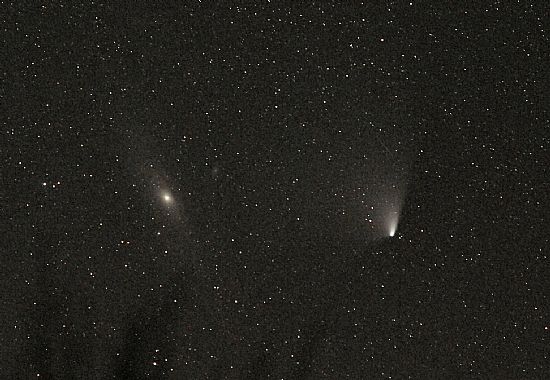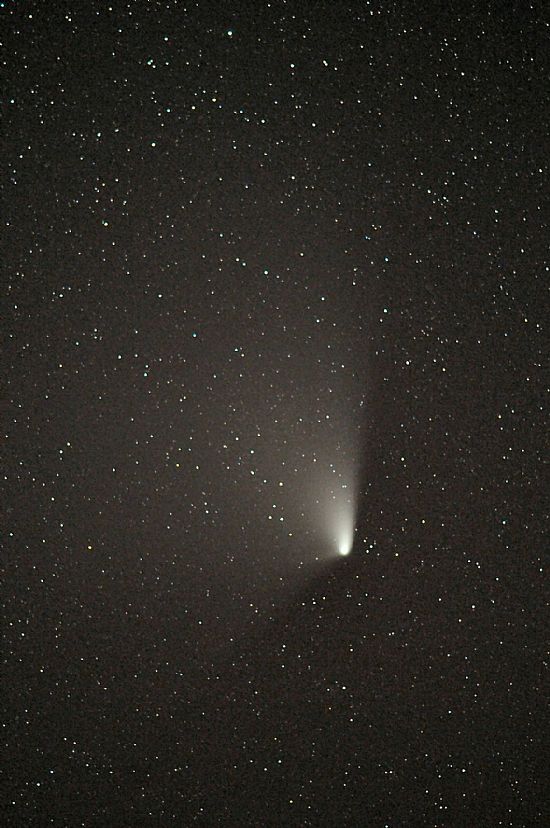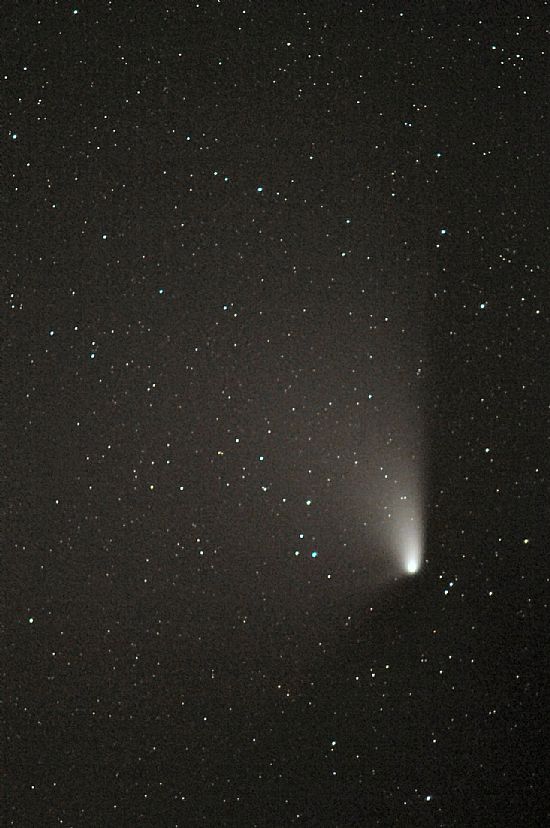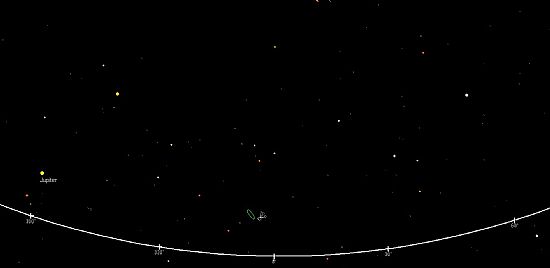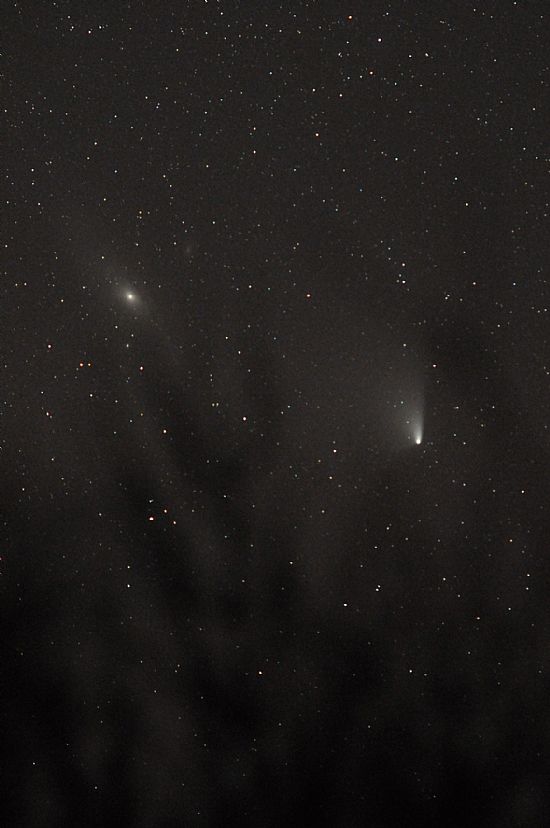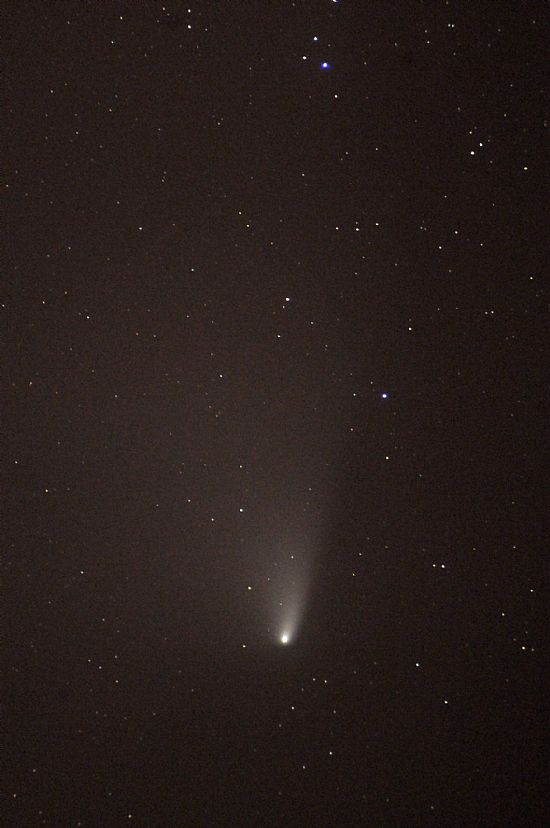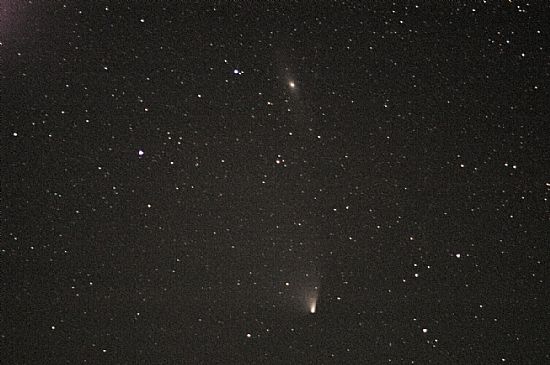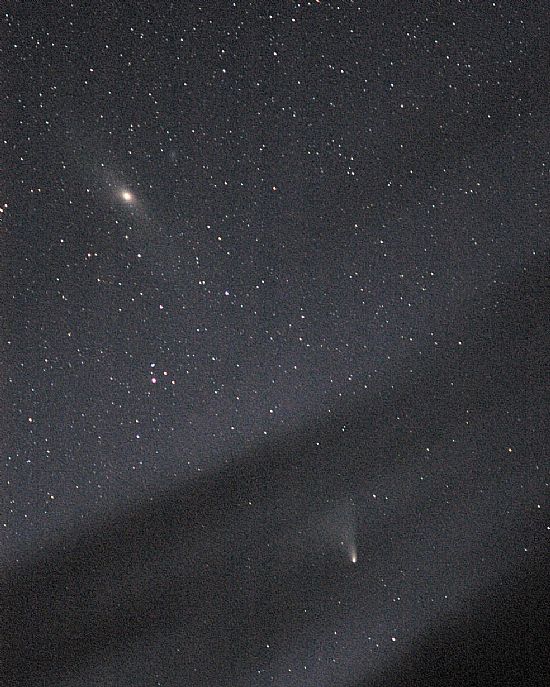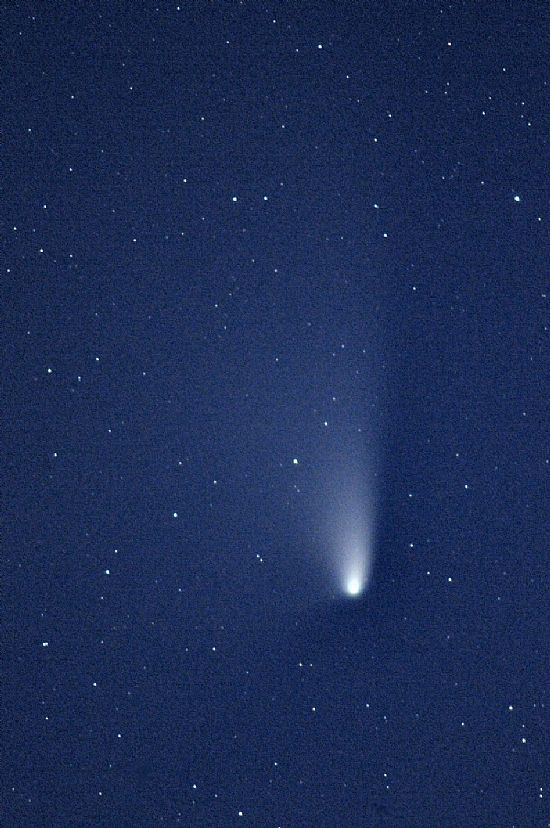 NORTHERN SKIES | sitemap | log in NORTHERN SKIES | sitemap | log in
|
 |
||
| This is a free Spanglefish 1 website. | ||
Comet C/2011 L4 PanSTARRS2013 Septemebr 29: Farewell to Comet PanSTARRS? Our observations of 2013 September 29 will almost certainly be the last we shall be able to make from Orkney. The comet is losing declination and by October 16 will no longer be circumpolar from here. The loss of altitude in a dark sky makes it impossible to capture so faint an object even with our fastest and largest lenses simply because sky illumination and poor transparency swamp the field. The observations from 29 September were made under trying conditions with a force 7, SSE wind and fleeting cloud forming and dispersing on the instant over the central hills of Rousay, below which the comet is now setting for us. Even the south-meridian sky offered indifferent transparency for observations of Nova Delphinus which has now dropped to around visual magnitude 7.8 or a little fainter. (A feature on the nova will follow shortly.) The image shows the comet at the centre of the field (dia. 2°) as a very faint “smudge” between the two stars TYC 2567-1397-1 (top) mag. 12.50 and GSC 2567-0244 (lower) mag. 13.10. The brightest star in the field is TYC 2567-1053-1 mag. 8.26, specgtral class G5. Nikkor 400mm f/2.8, D300 SLR ISO 2000: a 45 sec. exposure. (Left click to enlarge.) Note: Slight distortion of images due to wind "shake".
2013 Septemebr 25 Comet PanSTARRS imaged 2013 September 25 at 20h 21m UT.
150mm f/5 achromatic refractor. A 45 sec. exposure, D300 SLR ISO 2000. 2013 Septemebr 07 2013 September 07, 21h 52m UT. Nikkor 600mm f/4/. A 50 sec. exposure D300 SLR ISO 2000. The brightest star in the field (dia. 84' approx.) is TYC 3045-492-1 mag. 6.19 (spectral class K2III). Transparency poor at times (low cloud coming and going). Frequent spoiling of images by artificial Earth satellites crossing field (sample below).
2013 September 07, 22h 51m UT. Nikkor 600mm f/4/. A 50 sec. exposure D300 SLR ISO 2000. (Left click to enlarge images.)
2013 Septemebr 05 Comet PanSTARRS imaged 2013 August 05, 21h 41m UT. Nikkor 600mm f/4, D300 SLR. A 45 sec. exp. ISO 2000. The comet is at the centre of the field (72' dia. approx.). The brightest star in the field is TYC 3045-1229-1, mag. 7.72,Spectral class: K0. Stars to visual mag. 16 are visible n high-resolution images. (Left click to enlarge.) 2013 Septemebr 02 2013 September 02: another brief opportunity to image Comet PanSTARRS in a relatively dark sky between cloud breaks in otherwise appalling weather conditions (wind, rain and low cloud). 150mm f/5 achromatic refractor. A 50 sec. exposure D300 SLR ISO2000. (Left click to enlarge.) The comet is at the centre of the field (dia. 54' approx.). The galaxy NGC 5853 is to be seen below at 5’Oclock at a separation of 21'. In addition a pair of galaxies close to the star TYC 3044-1147-1 (mag. 9.46) may be seen at the edge of the field, far right. Galaxy data:
NGC 5853
PGC 53854
PGC 53855 The point to note is that the comet is passing across the stellar background away from the plane of the Milky Way (our galaxy) such that we can look well into the cosmic distance where there are hundreds of faint galaxies to be seen brighter than visual magnitude 18. 2013 August 30.
Comet Panstars imaged 2013 August 30 at 22h 48mm UT. The distant galaxy UGC 9691 is readily seen 15' 35" distant immediately below the comet. (Left click to enlarge.)
Data for: UGC 9691 In addition, there are four other faint galaxies in the field. An opportunity snatched (literally) between showers with a force 7 westerly blowing. Discussion: What is the purpose in following this comet when it appears as little more than an indistinct fuzz? First, habit, I suppose. When I first started to observe comets seriously in the late 1950s it should be remembered there were no computers, as we understand them today (the microchip versions). In the case of distant comets we were concerned mainly in securing astrographic observations for positional purposes to check on orbital elements and so forth. One still does this today, of course, but the range of participants involved in this work way exceeds our activities back then. Second, out of curiosity from a photometric angle—just how well are our predictions for apparent brightness (magnitude) borne out in practice? This can have value in assessing the behaviour of other comets in this regard. Third, to keep one’s hand in—the challenge, in other words. Astronomy is not all about securing stunning pictures of things out there, and I have always tended to be something of a backroom boy.
2013 August 08. 2013 Aug. 08, 00h 20m UT. 200mm f/8 Ritchey–Chrétien, 65 sec. exp. ISO 1600: D300 SLR. (Greyscale.) The brightest star in the field (dia. 30' approx.) is TYC 3477-747-1 mag. 10.08, stars to mag. 16 are visible on high resolution images. The comet is situated a little below the centre of the field. (Left click to enlarge.) 2013 July 31/August 01. Following a day of almost continuous clear sky, the evening and night remained clear until the early hours of August 01. Despite the presence of twilight, together with a crescent Moon, it was possible to image the comet throughout a 50 minute period when the sky was at its least bight (sufficient to make out the Milky Way, the closest to summer solstice I have seen it from Orkney. The Comet "approaching" the star GSC 3479-0139 (mag. 13.58).
The first image was taken at 2013 July 31 23h 24m UT, the second image, 45 minutes later, at 2013 August 00h 09m UT.
Imaging data: 150mm f/5 achromatic refractor. Exp. 25 sec. ISO 1600, D300 SLR. (The comet is to be seen at the centre of the circled area for the first image.) The comet may be seen to have moved closer to GSC 3479-0139 in the second image. (Left click images to enlarge.) The comet’s data for 2013 Aug. 01. 00h 09m UT.:
Right Ascension: 14h 41m 22.5s
Unprocessed image: To indicate the level of sky illumination. The brightest star in the field (far right) is TYC 3479-568-1 mag. 6.95. Photographic data: 150mm f/5 achromatic refractor. Exp. 25 sec. ISO 1600, D300 SLR.
Sun at lower transit: 2013 Aug 01, 00h:15m UT. Twilight: Sun’s Altitude: -12° 50' 9" which is a little outside the threshold for nautical twilight (Sun’s altitude between –6° and -12°). Astronomical twilight (Sun’s altitude between –12° and -18°) lasts all night for our latitude up to Aug. 19. Note: there were noctilucent clouds visible close to the northern horizon around true midnight and at the time of these observations.
Ancillary data: Data for Moon at 2013 Aug. 01, 00h 09m UT:
Right ascension: 4h 12m 7.21s
Resumption of PanSTARRS observations 2013 July 29. Comet C/2011 L4 ( PanSTARRS ) 2013 July 29, 23h 33m UT. This photograph, obtained under exacting conditions with high cloud forming and reforming, together with drifting sea mist and significant twilight, seeks to achieve the impossible! Current estimates for the magnitude of the comet vary from around mag. 9.5 to anything half this bright. Integrated magnitudes at this level are bound to vary a good deal. Whether or not we have the comet on this image (in greyscale for better detection) is open to question. We look forward to darkening, clear skies shortly. 150mm f/5 achromat. D300 SLR ISO 1600, exp. 20 sec. (Left click to enlarge.) The brightest star in the field is TYC 3479-146-1 apparent visual magnitude 7.17. Stars to mag. 13,5 or a little fainter may be detected on the high resolution image.
Positional data at time of observation:
2013 May 15: Comet PanSTARRS has become a very difficult object for high latitude observers due to fading brightness and strong, summer twilight. An important point of note with our observations is that the fast lenses of moderate focal length enable images to be secured in a relatively shot time. This is vital when atmospheric conditions may limit one to a few minutes of time in which to secure results. Additionally, these lenses give a wider field than do telescopes of comparable aperture unless they too have low “f“ ratios. All our images are single exposures, lightly processed but never “stacked”. UPDATE 2013 May 01/02. The daylight hours of May 01 saw high winds from the NW gusting to force 9 with frequent, light snow showers. By 2000h UT the wind had eased down to force 5/6 and the sky cleared. The wind eased further but around 2200h UT more cloud came in from the NW making opportunities for observing the comet look decidedly unpromising. Then at 2300 UT the sky cleared and remained relatively cloud free for the following two hours. There was a faint auroral glow with a short-lived display of rays at around 2340 UT. We used the Nikkor 400mm f/2/8 alone and in combination with the 2x converter to register some of the finest images of the comet yet.
Comet PanSTARRS in the constellation Cepheus (barely seen here ringed above Cassiopeia) riding above the northern, auroral glow. Nikkor 24mm f/2.8 cropped image. A 25 sec. exposure ISO 500. Static D100 camera. (Left click to enlarge.) Comet PanSTARRS imaged 2013 May 02 at 00h 17m UT. Nikkor 400mm f/2.8. A 40 sec. exposure D300 ISO 1600. Field 3.4° x 2.4°approx. (Left click to enlarge.)
Comet PanSTARRS imaged 2013 May 02 at 00h 17m UT. Nikkor 400mm f/2.8. A 40 sec. exposure D300 ISO 1600. The brightest star in the field (cropped image, dia. 1.8° approx.) is TYC 4294-80-1 (mag. 7.41). Comet PanSTARRS imaged 2013 May 02 at 00h 06m UT. Nikkor 400mm f/2.8 coupled with 2x converter (800mm f/5.6) A 50 sec. exposure D300 ISO 1600. The brightest star in the field (dia. 56') is TYC 4294-614-1 (mag. 8.15). Stars to 16.5 mag. and fainter are visible. (Left click to enlarge.) Data at May 02, 0001h UT:
Right Ascension: 0h 10m 33.8s
Computed magnitude: 7.6 UPDATE 2013 April 29. Following a day of high winds and frequent squally showers much the same pattern continued into nightfall with a few clear intervals around 23-00h UT. Work with the 150mm achromatic refractor proved impossible due vibration from wind. Some interesting images were obtained with the smaller Nikkor 400mm f/2.8. (Conditions did not allow finer focussing adjustments to be made.) Twilight was a factor, also, in addition to a vessel moored less than 2 kilometres away in Rousay Sound and lit to high heaven! 2013 April 29, 23h 17m UT. Nikkor 400mm f/2.8. A 20 sec. exposure D300 ISO 1600. The brightest star in the field (dia. 2°) is the variable V398 Cephei (mean mag. 6.35). Left click to enlarge.
UPDATE 2013 April 25. Observations of Comet Panstartrs on the night of April 25, 2013. Following a day of variable cloud and gale force winds from the NWW the wind fell to force 3 by 21h UT. The main problems now came from a bright sky background due to the full Moon and twilight. The objective to these observations was twofold, first to determine the magnitude of the coma and to calibrate the focus to infinity for the 400mm f/2.8 Nikkor lens. 2013 April 25, 22h 17m UT. Nikkor 400mm f/2.8 (2x converter 800mm f/5.6). 8 sec, exposure D300 ISO1600. The brightest star in the field (dia. 1 ) is in fact a complex system comprising three stars GSC 4018-3381(mag. 7.11), GSC 4018-3890 (mag. 8.0) and a third star giving a combined magnitude of 6.84). [Left click to enlarge.] The group appear to the right of the comet (centre) immediately above the star TYC 4018-3897-1 (mag. 8.54 separated by only 14" from the centre of the triple system). The triple itself is not resolvable on the photograph. Data for time of observation. Comet:
Right Ascension: 0h 17m 46.1s Computed magnitude: 7.1
Elongation: 53.5° Moon:
Right ascension: 14h 19m 11.87s
UPDATE 2013 April 21, 21h 23m to 21h 49m UT. Observations in significant twilight and Moon close to the meridian at phase 81.6%. The most that one could hope to achieve under these conditions was to secure images for magnitude estimates of the coma.
Tokina 300mm f/2.8. A 6 sec. exposure D300 ISO 1600. The brightest star in the field (dia. 2.5° approx.) is the variable star TV Cassiopeiae TYC 3665-546-1 (mean mag. 7.22). Stars to mag. 12 are visible.
UPDATE 2013 April 17 (early hours): The night of April 16/17 started off cloudy with a strong SSW wind force 7 gusting to 8. The sky began to break up in the early hours of the 17th with the wind slowly moderating. (Wind is a consideration in the choice of instruments since the larger lenses/telescopes can vibrate in winds of force 6 or more.) The Moon (phase 36%) set at 1h 33m UT on the 17th. The first observations were made at 01h 00m and imaging went on until 01h 51m UT by which time twilight was beginning to become a factor in the north. It will be seen, therefore, that the window of opportunity for dark skies is decreasing by the day. In fact, astronomical twilight from the latitude of Orkney will last all night through to mid-August commencing April 25. Sky clarity this night was not of the best with low, tenuous cloud always close to the northern horizon. However, the comet was plainly seen in 8x30 binoculars but was beyond naked eye visibility. This, quite fortuitously, could mean that tonight’s observations will be the last we may secure of the comet before it fades to very low levels. The images were secured using the fast 400mm f/2.8 for detail and the much shorter focal length 24mm f/2.8 and 105mm f/1.8 for wide field. 2013 April 17, 01h 41m UT: Nikkor 24mm f2.8. A 20 sec. exposure with static camera (D100 ISO 800). The Andromeda galaxy appears at the very bottom of the frame mid-right, below the comet. The comet is ringed. (Left click to enlarge.) 2013 April 17, 01h 49m UT: Nikkor 105mm f1.8. An 8 sec. exposure with static camera (D100 ISO 800). The comet is to be seen to the left of the trapezium of stars well shown in the two frames below. (Left click to enlarge.)
2013 April 17, 01h 20m UT: Nikkor 400mm f/2.8. A 40 sec exposure D300 ISO 1600. The brightest star in the field (left) is lambda Cas. mag. 4.77. 2013 April 17, 01h 20m UT: Nikkor 400mm f/2.8. A 40 sec exposure D300 ISO 1600. Cropped image: the brightest star in the field (left) is TYC 3657-1700-1 mag. 7.1. Stars to mag. 16.5 are visible. (Left click to enlarge.)
Update 2013 April 14: Difficult conditions. A force 7 wind from the south, variable, mostly thin cloud, and a Moon, phase 18.6% at an angular separation from the comet of 61°. Observations were limited to a 30 minute slot.
2013 April 14, 22h 33m UT. Nikkor 400mm f/2/8; a 40 sec. exposure D300 ISO 1600. (Left click to enlarge.) The comet is now traversing the Milky Way as background with a plethora of stars making for a stunning, overall picture. The data for the comet at this time was as follows:
Right Ascension: 0h 25m 21.1s Update 2013 April 12: An exceptional night with the sky clear from dusk to dawn with only an occasional civil aircraft passing over at high altitude to mar the serenity. Commenced observations at 21h 53m UT using Nikkor 600mm f/4 lens and D300 SLR. Later switched to 50mm and 105 mm lenses for wide field to show comet in relation to Andromeda Galaxy (M31, below) and the constellation Cassiopeia (above). Completed observations with fast 400mm f/2.8 lens alone and in combination with a 2x converter. 2013 April 12, 22h 20m UT Nikkor 50mm f/1.4 stopped down to f/2 A 20 sec. exposure, D100 ISO 800. (Left click to enlarge.)
2013 April 12, 22h 20m UT Nikkor 105mm f/1.8. A 20 sec. exposure, D100 ISO 800. 2013 April 12, 23h 18m UT Nikkor 400mm f/2.8. A 45 sec. exposure, D300 ISO 1600. (Left click to enlarge.) Update 2013 April 11: Another night of varying quality (transparency) with cloud coming and going.
2013 April 11, 23h 28m UT Nikkor 600mm f/4 55 sec. exposure, D300 ISO 1600 Update 2013 April 10: Early morning observations with further notes for identification. The comet is becoming a distinctly “anti-social” observational challenge. Still bright enough to be glimpsed with the unaided eye, it shows readily in a small binocular. But these conditions are only likely to be achieved for the following week at most. With advancing twilight (and presence of the Moon 16 to 28 April), and as the comet gains in northern declination, so the opportunities for observation become increasingly centred around lower transit in the north. This means that the darkest skies are to be had in the very early hours rather than late evening. Comet PanSTARRS imaged 2013 April 10 at 02h 04m UT. Nikkor 600mm f/4. A 30 sec. exposure, D300 ISO 1600. (Left click to enlarge.) Update 2013 April 08: A night of varying quality (transparency) with cloud coming and going. Commenced observations at 20h 35m UT in strong twilight using the fast 150mm aperture f/4 achromatic refractor. Switched to the 132 mm f/7 apochromatic refractor at 22h 30m UT. By 23h 00m UT cloud had started to cover the entire sky, except low down in the north when the final image of the series was taken.
2013 April 08, 21h 38m UT. 150mm f/5 achromat. 45 sec. exposure D300 ISO 1600.
2013 April 08, 21h 38m UT. 132mm f/7 apohro. 65 sec. exposure D300 ISO 1600. A study in motion: Cropped images showing the coma in relation to nearby stars from 21h 20m UT to 23h 00m UT. (First pair 150mm f/5, second pair 132mm f/7.)
2013 April 08, 21h 20m UT.
2013 April 08, 21h 38m UT.
2013 April 08, 22h 32m UT.
2013 April 08, 23h 00m UT.
Update 2013 April 07: A frustrating evening and night following a day of almost uninterrupted sunshine, Kirkwall registering as the sunniest location in the UK. There was a brief clearance in the north from around 22h; this enabled us to use the fast 400mm f/2.8 lens in order to secure some good images in a dark sky in quick time. 2013 April 07, 22h 37m UT. Nikkor 400mm f/2/8 A 30 sec. exposure D300 ISO 1600. The brightest star in the field (2.4° x 3.3° approx. ) is TYC 2795-2706-1 (nag. 5.18) Stars to mag., 15 or slightly fainter, are visible. (Left click to enlarge.)
Update 2013 April 04: The best night so far in terms of sky transparency, though slow moving, passing cloud groups proved troublesome in the early stages. In consequence, it was decided to use the ultra-fast medium focus 400mm lens with smaller, faster lenses for wider fields. Conditions stabilized as the comet approached lower transit enabling the use of the largest telephoto lens 600mm f/4. (Note: NOT all images may be enlarged.)
2013 April 04. A wide angle view of the sky looking NNW at 22h 10m UT. Nikkor 50mm f/1.4 stopped down to f/4. A 25 sec. exposure D100, ISO 800. 2013 April 04. A closer look at the Andromeda Galaxy (left) and Comet PanSTARRS imaged at 22h 23m UT. Nikkor 200mm f/2 stopped down to f/4. A 25 sec. exposure, D300 ISO 1600. (Left click to enlarge.)
2013 April 04. Comet PanSTARRS imaged at 22h 01m UT. A 13 sec exposure Nikkor 400mm f/2.8, D300 ISO 1600.
2013 April 04. Comet PanSTARRS imaged at 23h 28m UT. A45 sec. Nikkor 600mm f/4, D300 ISO 1600. Note the positional data for the comet at this time as it approached lower transit: Constellation: Andromeda; Right Ascension: 0h 30m; Declination: +41° 33'; Altitude: 10° 50'; Azimuth: 356° 49'. The rapid motion of the comet (3 arc-minutes, or 160 arc-seconds, per hour) is well shown when comparing its position relative to the small triangle of stars to the right: the later image clearly shows the increase in declination. Update 2013 April 03: The day and early evening of April 03 did not portend a favourable opportunity for observing at night. However, the sky began to clear at around 21h UT and by 21h 20 UT it was possible to make out through a thin veil of cloud both Comet PanSTARRS and M31 in close company as they dipped towards the northern horizon. The observing stand is not well positioned for observing the northern horizon but by now the comet had exceeded +40° declination, and so it was possible to snatch a series of observations with both wide angle and relatively high powers. At lower transit (23h 47m UT) the comet had an altitude from Rousay of 9° 36'. We infract secured an image with the 150mm aperture f/5 refractor at 23h 27m (see below); to have waited for transit would have brought the comet in line with shrubs nearby. It has to be understood that at this altitude one encounters problems of atmospheric occlusion which exacerbated light pollution from the ground (notably sodium lighting etc, locally a from the island of Westray 12 miles distant). It was found that exposures with this instrument reached an optimum at around 50 seconds of time – longer exposures quickly became “fogged”. One rarely has the opportunity to observe a comet so close to a bright galaxy as occurred with PanSTARRS and M31, with which it compared so closely in both angular diameter and apparent surface brightness. 13 April 03, 23h 27m UT. Diagrammatic view of the sky looking north to show relative position of M31 , PanSTARRS and the northern horizon. (Left click to enlarge.) 13 April 03, 22h 10m UT. Nikkor 200mm /f2. stopped down to f/4. A. 30 sec. exposure D300 ISO 800. M31 and the comet riding above the shrubbery. (Left click to enlarge.) 13 April 03, 23h 27m UT. 150mm f/5 achromat. A 50sec. exposure D300 ISO 800. The brightest star in the field (55' x 40' approx.) is TYC 2787-1032-1, mag. 7.96. Stars to mag. 13 are visible. (Left click to enlarge.)
The presence of Comet PanSTARRS in the northern hemisphere as it appears to pass the bright, elliptical galaxy M31 in Andromeda provides an interesting and useful exercise in magnitude assessment for an extended, diffuse object in the night sky. The concept involved is to condense the object’s light into a point so as to simulate the appearance of a star and to give the corresponding apparent visual magnitude The most commonly accepted integrated apparent visual magnitude for M31 is 3.5. (Note the ordinarily reliable editions of NORTON’S Star Atlas omits a magnitude for M31 but quotes 8th magnitude for the companion elliptical galaxy M32.) Published ephemeredes for Comet PanSTARRS estimate a magnitude of 4.2 for 2013 March 31. On the face of, it this would appear to be a reasonable estimate when one compares the two objects on the image below. At its discovery, in June 2011, the comet would have had an almost stellar-like appearance (digital image) and was estimated at magnitude 19. By early May 2012, the comet had brightened to magnitude 13.5, still beyond the reach of visual observations except with large apertures.. The comet was seen without optical aid on 7 February 2013 with an estimated magnitude of 6.0. It is likely the comet’s brightness will fade beyond naked eye visibility within the next six to eight days. 2013 March 31, 21h 20m UT. Nikkor 24mm f/2.8. A 10 sec exposure on static D100 SLR, ISO 800. Andromeda Galaxy (M31) above the comet: separation around 5 arc-degrees (centre to centre). Left click to enlarge. 2013 April 01: Observastions: Observations on the evening and early night of April 01 were hampered by advancing bands of cloud from the NE. This foiled an attempt to get a good, clear image of the comet as it approaches the sky in the vicinity of M31. (See below.)
2013 April 01, 20h 43m UT. Nikkor 135mm (f/2.82x. A 20 sec. exposure D100 ISO 800. The 500mm f/4 Nikkor lens was used with a 2x converter (below), in addition to the lens itself, but both twilight and low altitude for the comet made for less than ideal conditions.
2013 April 01, 20h 38m UT. Nikkor 500mm f/4 (f/8) 2x converter. A 45 sec. exposure D300 ISO 1200. The brightest star in the field (75'x55' approx.) is TYC 2784-180-1, mag. 8.52.
|  |
|
 | ||




















